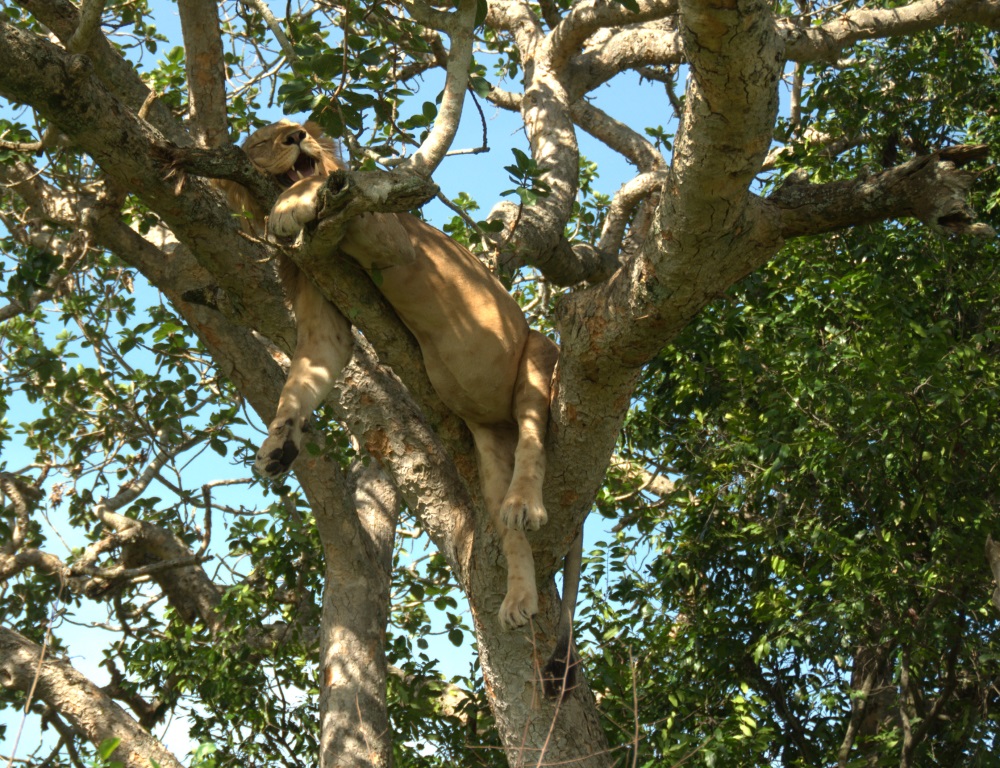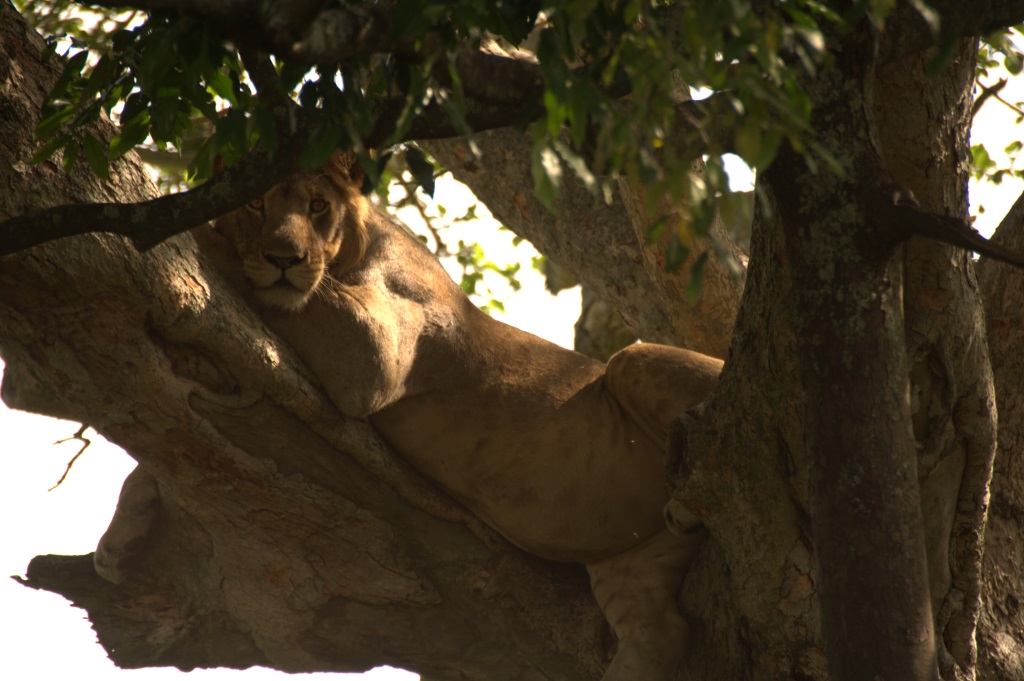Our next stop was the southern Ishasha section of the Queen Elizabeth National Park (QENP). With clear skies all the way we made our way through the twisting and winding tracks of the mountains, over the escarpment and into the blazing heat of the open plains.
Our home for the next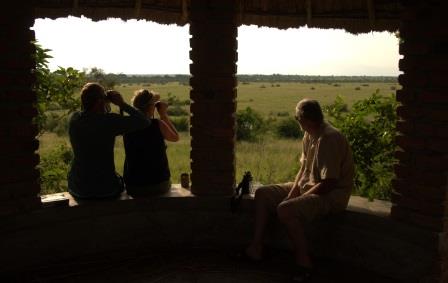 few days was the Ishasha River Camp situated on the banks of the Ishasha River, which also forms the border to the DRC about 30 meters away. As in Bwindi, our campsite was protected by the Tourism Police and their AK47’s for the duration of our visit. A rather unnerving experience, not from a security point of view, but simply because these guards spent their entire day watching us. Whether we were reading, cooking, eating, drinking or playing cards, there was always someone watching you.
few days was the Ishasha River Camp situated on the banks of the Ishasha River, which also forms the border to the DRC about 30 meters away. As in Bwindi, our campsite was protected by the Tourism Police and their AK47’s for the duration of our visit. A rather unnerving experience, not from a security point of view, but simply because these guards spent their entire day watching us. Whether we were reading, cooking, eating, drinking or playing cards, there was always someone watching you.
The campsite itself was lovely though. Within the first half an hour we had spotted a family  of the Abyssinian Black and White Colobus monkeys happily sitting in the tree canopy, the hippos were playing in the water in front of us and the dense forest surrounding us constantly presented us with flashes of flying colours that had to be observed with binoculars, discussed and identified. It was a wonderful spot to truly enjoy the bush life surrounding us.
of the Abyssinian Black and White Colobus monkeys happily sitting in the tree canopy, the hippos were playing in the water in front of us and the dense forest surrounding us constantly presented us with flashes of flying colours that had to be observed with binoculars, discussed and identified. It was a wonderful spot to truly enjoy the bush life surrounding us.
Having taken our time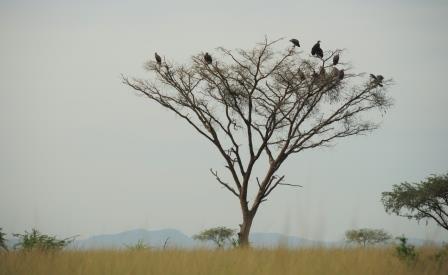 to settle in comfortably, we had our first game drive later that afternoon. We had heard quite a bit about the tree climbing abilities of the local lion population and soon decided that their preferred hang-out (sorry, I couldn’t resist :-)) should be our first stop. The guidebooks and maps had a few fig trees marked as possible locations to spot the lions in the trees, however there was no guarantee that we’d actually see them.
to settle in comfortably, we had our first game drive later that afternoon. We had heard quite a bit about the tree climbing abilities of the local lion population and soon decided that their preferred hang-out (sorry, I couldn’t resist :-)) should be our first stop. The guidebooks and maps had a few fig trees marked as possible locations to spot the lions in the trees, however there was no guarantee that we’d actually see them.
Driving through this area, looking at all possible fig trees, we drove past the same fig tree we’d driven past 10 minutes before. Coming from a different direction, we suddenly spotted three lions hanging in the branches, their extremely fat bellies propped between the branches. We hadn’t seen them before as they were lying as still as possible in the densest patch of shade they could find.
Wow! Although we had obviously hoped to find them in the trees, none of us had actually expected it and to see three of them so nonchalantly resting was absolutely fantastic.
Two of the three lions were happily dozing, at most opening an eye to peek at us, or letting forth a spectacular yawn, but the last one couldn’t quite find the perfect position. For the 30 minutes we spent watching them, he was constantly shifting, moving his paws or belly into a better position, getting up, pacing from branch to branch, flopping down in a new position, only to get up again and find the next spot. It was comical to watch. We got the distinct impression that the uncomfortable lion’s two siblings were occupying the best spots and he was left to make do with what was left over. 🙂
As the afternoon came to a close, we slowly had to head back to camp. A few hundred meters further along the track we drove past another fig tree and spotted another two lions quietly sleeping in the shade and not interested in the least in us or anything else.
Elated with the day so far, we almost missed the Verreaux’s (Giant) Eagle-Owl peering at us through the shrubland…
Waking up to a rainy day the next morning we decided to try to reach the swamps on the edge of Lake Edward to track down the ever elusive Shoebill. 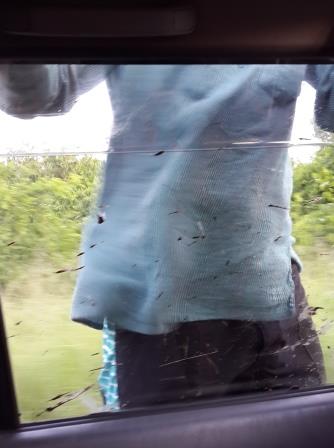 We had heard reports that they could be sighted along this stretch of the Lake, but that the access road was pretty much impassable. Not ones to shy away from a worthy challenge, we piled ourselves into the rented Prado and finally found the access road.
We had heard reports that they could be sighted along this stretch of the Lake, but that the access road was pretty much impassable. Not ones to shy away from a worthy challenge, we piled ourselves into the rented Prado and finally found the access road.
Tracking ahead of the car, Chris had the dubious honour of checking each mudhole and bog before deciding the best route for the car through the obstacle. Soon he was too dirty to be let back into the car, so he spent the time between obstacles hanging onto the roof rack and being scraped by any bushes and thorn trees along the way. His cleanliness was also reduced by each puddle we drove through, as we had to have sufficient speed so as not to get stuck in the mud.
All too soon we had to turn back though. 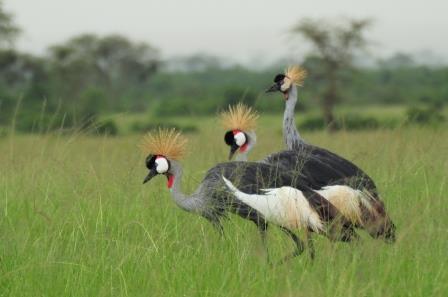 According to the map, we had only managed a small section of the road and it was only going to get worse. Scouting ahead on foot, the unanimous decision was to abandon the shoebill hunt, turn around and take a more comfortable and relaxing route back to camp and easier bird targets.
According to the map, we had only managed a small section of the road and it was only going to get worse. Scouting ahead on foot, the unanimous decision was to abandon the shoebill hunt, turn around and take a more comfortable and relaxing route back to camp and easier bird targets.




